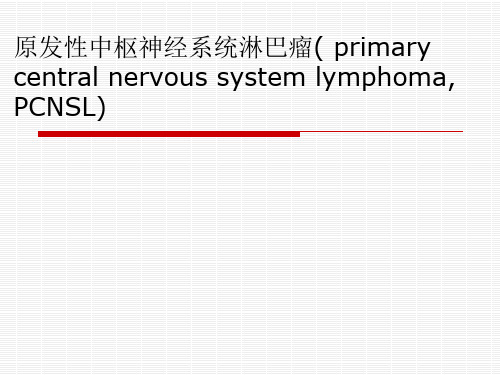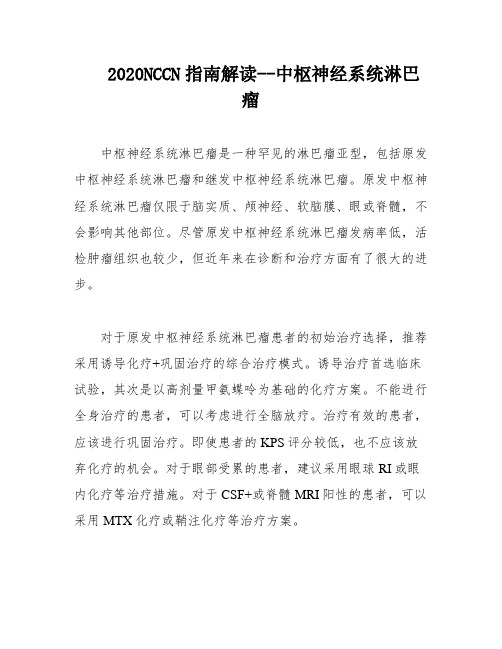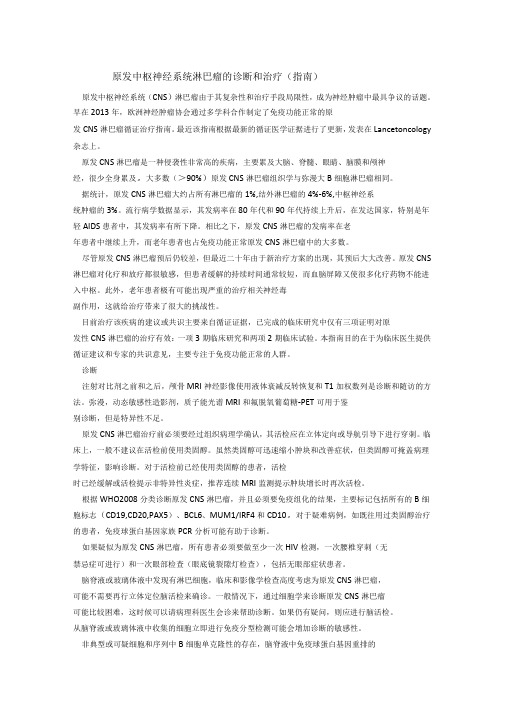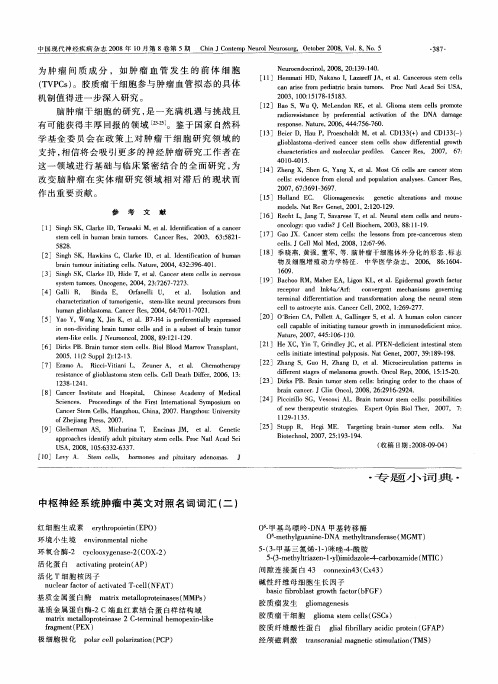cns中枢神经系统肿瘤 NCCN 翻译
中枢淋巴瘤CNSL

The periventricular contrast-enhancing tumor (A ) in the left parietal lobe has restricted diffusion with high signal intensity on DWI (C ) with corresponding low signal intensity on the ADC map(arrows, D ). Perfusion MR imaging shows low perfusion within the contrast-enhancing tumor on the rCBV map (arrows, E ).
鉴别
①胶质瘤:为颅内最常见的肿瘤。CT 多呈混 杂低密度灶;MRI 呈长T1长T2信号,易出 现囊变、出血及坏死,增强呈不规则斑片状 或花环样强化,环壁厚薄不均。均匀强化的 胶质瘤与淋巴瘤较难鉴别,PWI 呈低灌注、 1H-MRS 出现异常高耸的脂质峰
② 脑膜瘤:与PCNSL 的密度及信号特点相似, 靠近脑膜的PCNSL 亦可浸润脑膜引 起脑膜尾征,鉴别困难。脑膜瘤属于脑外肿 瘤,可见“白质挤压征”、MR 灌注成像多 呈高灌注等有利于鉴别。
镜下见瘤细胞多围绕在血管周围呈簇状分布; 细胞体积偏大,核仁明显,核分 裂像多见(HE 染色,×200)
瘤细胞侵犯血管壁使血脑屏障( blood brain barr ier, BBB) 破坏, 血管通透性 vascular permeability (Ktrans)增加。 肿瘤沿血管周围间隙生长,因此可沿VR间隙 播散。 据报道,75%淋巴瘤可累及室管膜或硬膜 或二者同时受累。
Contrast-enhancing lesions on CT scans (A–D ) in 4 patients with AIDS-related PCNSL. Note irregularly enhancing lesions in the right parietal lobe (A ), right occipital lobe (B ), and right periventricular white matter (C and D ); most of the lesions show ring enhancement (A, B, and C ).
2020NCCN指南解读--中枢神经系统淋巴瘤

2020NCCN指南解读--中枢神经系统淋巴瘤中枢神经系统淋巴瘤是一种罕见的淋巴瘤亚型,包括原发中枢神经系统淋巴瘤和继发中枢神经系统淋巴瘤。
原发中枢神经系统淋巴瘤仅限于脑实质、颅神经、软脑膜、眼或脊髓,不会影响其他部位。
尽管原发中枢神经系统淋巴瘤发病率低,活检肿瘤组织也较少,但近年来在诊断和治疗方面有了很大的进步。
对于原发中枢神经系统淋巴瘤患者的初始治疗选择,推荐采用诱导化疗+巩固治疗的综合治疗模式。
诱导治疗首选临床试验,其次是以高剂量甲氨蝶呤为基础的化疗方案。
不能进行全身治疗的患者,可以考虑进行全脑放疗。
治疗有效的患者,应该进行巩固治疗。
即使患者的KPS评分较低,也不应该放弃化疗的机会。
对于眼部受累的患者,建议采用眼球RI或眼内化疗等治疗措施。
对于CSF+或脊髓MRI阳性的患者,可以采用MTX化疗或鞘注化疗等治疗方案。
在诱导治疗方案的选择上,最有效的单药是高剂量甲氨蝶呤,推荐的方案包括R-M、R-MPV、R-MT CALGB和R-MPV ANOCEF-GOELAMS试验等。
此外,还有MA方案和MATRiX方案等联合静脉化疗方案可供选择。
这些方案的选择应该根据患者的具体情况进行综合考虑。
总之,对于原发中枢神经系统淋巴瘤患者,及时的诊断和治疗是至关重要的,可以有效提高治疗效果和预后。
维持治疗是目前针对PCNSL探索较多的新的治疗方式。
由于复发率高,维持治疗可以延缓复发。
多种药物被尝试作为PCNSLS患者的维持治疗,包括口服化疗药物如HD-MTX、替莫唑胺和甲基苄肼,抗体类药物如利妥昔单抗和GA101,以及能透过血脑屏障、在复发难治PCNSL有一定疗效的小分子靶向药物如来那度胺和伊布替尼。
目前维持治疗持续时间从6个月至2年不等,少数如伊布替尼的临床试验是持续应用至疾病进展。
虽然维持治疗值得探索,但是还需要进一步的前瞻性试验来进一步明确其有效性。
挽救治疗是PCNSL患者中不得不面对的治疗方式。
由于10-15%的患者发生原发耐药,近50%的患者将面临复发,无论是原发耐药还是疾病复发的患者,其预后都非常差。
中枢神经系统 英文汇总

中枢神经系统英文汇总English: The central nervous system (CNS) is the part of the nervous system consisting of the brain and spinal cord. It is responsible for integrating and coordinating sensory information as well as controlling and regulating bodily functions. The brain, which is the control center of the CNS, receives and processes information from the body's senses, initiates responses, and stores memories. The spinal cord connects the brain to the rest of the body and serves as a pathway for transmitting nerve signals between the brain and the peripheral nervous system. The CNS plays a crucial role in motor function, cognition, emotion, and behavior, and any damage or dysfunction in this system can have significant impacts on an individual's physical and mental health.中文翻译: 中枢神经系统(CNS)是由脑和脊髓组成的神经系统的一部分。
原发中枢神经系统淋巴瘤的诊断和治疗指引

原发中枢神经系统淋巴瘤的诊断和治疗(指南)原发中枢神经系统(CNS)淋巴瘤由于其复杂性和治疗手段局限性,成为神经肿瘤中最具争议的话题。
早在2013年,欧洲神经肿瘤协会通过多学科合作制定了免疫功能正常的原发CNS淋巴瘤循证治疗指南。
最近该指南根据最新的循证医学证据进行了更新,发表在Lancetoncology 杂志上。
原发CNS淋巴瘤是一种侵袭性非常高的疾病,主要累及大脑、脊髓、眼睛、脑膜和颅神经,很少全身累及。
大多数(>90%)原发CNS淋巴瘤组织学与弥漫大B细胞淋巴瘤相同。
据统计,原发CNS淋巴瘤大约占所有淋巴瘤的1%,结外淋巴瘤的4%-6%,中枢神经系统肿瘤的3%。
流行病学数据显示,其发病率在80年代和90年代持续上升后,在发达国家,特别是年轻AIDS患者中,其发病率有所下降。
相比之下,原发CNS淋巴瘤的发病率在老年患者中继续上升,而老年患者也占免疫功能正常原发CNS淋巴瘤中的大多数。
尽管原发CNS淋巴瘤预后仍较差,但最近二十年由于新治疗方案的出现,其预后大大改善。
原发CNS 淋巴瘤对化疗和放疗都很敏感,但患者缓解的持续时间通常较短,而血脑屏障又使很多化疗药物不能进入中枢。
此外,老年患者极有可能出现严重的治疗相关神经毒副作用,这就给治疗带来了很大的挑战性。
目前治疗该疾病的建议或共识主要来自循证证据,已完成的临床研究中仅有三项证明对原发性CNS淋巴瘤的治疗有效:一项3期临床研究和两项2期临床试验。
本指南目的在于为临床医生提供循证建议和专家的共识意见,主要专注于免疫功能正常的人群。
诊断注射对比剂之前和之后,颅骨MRI神经影像使用液体衰减反转恢复和T1加权数列是诊断和随访的方法。
弥漫,动态敏感性造影剂,质子能光谱MRI和氟脱氧葡萄糖-PET可用于鉴别诊断,但是特异性不足。
原发CNS淋巴瘤治疗前必须要经过组织病理学确认,其活检应在立体定向或导航引导下进行穿刺。
临床上,一般不建议在活检前使用类固醇。
虽然类固醇可迅速缩小肿块和改善症状,但类固醇可掩盖病理学特征,影响诊断。
中枢神经系统肿瘤中英文对照名词词汇(二)

3 7 8
为 肿 瘤 问 质 成 分 ,如 肿 瘤 血 管 发 生 的 前 体 细 胞
c n a ie fo p d a rc b an t mo . P o t Ac d S iUS a s r m e i t r i u r r i s r c Na l a c A.
2 o .1 0:51 8 1 8 . o 3 0 1 7 . 5l 3
脑肿 瘤 干细胞 的研究 , 是一 充 满机 遇 与 挑 战且
支 持 , 信将 会 吸 引更 多 的神经 肿 瘤研 究 工 作者 在 相
这 一领域 进 行基 础与 临床 紧密结 合 的全面 研 究 , 为
改 变 脑肿 瘤 在 实 体 瘤研 究 领 域 相 对 滞 后 的 现 状 而
作 出重要 贡献 。
参 考 文 献
[ ] SnhS , l k D T rsk M, t 1Iet ct no cne 1 ig K Ca eI , eaa i e a.dni ai f acr r i f o a
se c l i u n b a n t mo s Ca c rRe . 2 0 . 6 : 21 t m e l n h ma r i u r . n e s 0 3 358 — 5 2 . 8 8
mo e s d l.Na v Ge e .2 01 2 l O l 9 tRe n t 0 . : 2 — 2 .
[6 c tL a g T a aee _ ta.Ne rIse c lsa d n u o 1 ]Reh ,Jn ,S v s r 1 u a tm el n e r - r ’e
西医神经科、精神科术语英文翻译

西医神经科、精神科术语英文翻译以下是常见的西医神经科术语英文翻译:1. 神经学:Neurology2. 神经系统:Nervous System3. 大脑:Brain4. 脊髓:Spinal Cord5. 神经元:Neuron6. 神经胶质细胞:Glial Cells7. 突触:Synapse8. 轴突:Axon9. 树突:Dendrites10. 髓鞘:Myelin Sheath11. 神经递质:Neurotransmitters12. 神经传导通路:Nerve Conduction Pathways13. 反射:Reflex14. 痛觉:Pain Sensation15. 感觉运动传导通路:Sensorimotor Pathways16. 自主神经系统:Autonomic Nervous System17. 中枢神经系统:Central Nervous System (CNS)18. 外周神经系统:Peripheral Nervous System (PNS)19. 神经肌肉接头:Neuromuscular Junction20. 癫痫:Epilepsy21. 帕金森病:Parkinson's Disease22. 多发性硬化症:Multiple Sclerosis (MS)23. 脑卒中:Stroke24. 脑外伤:Traumatic Brain Injury (TBI)25. 脑瘤:Brain Tumors26. 脑炎:Brain Infections / Encephalitis27. 神经痛:Neuralgia28. 头痛:Headache29. 失眠:Insomnia30. 肌肉萎缩:Muscle Atrophy31. 肌无力:Muscle Weakness32. 神经根病:Radiculopathy33. 神经丛病变:Plexopathy34. 脊髓病变:Myelopathy35. 脑积水:Hydrocephalus36. 脊髓空洞症:Syringomyelia37. 脑电图(EEG):Electroencephalogram (EEG)38. 肌电图(EMG):Electromyogram (EMG)39. 经颅磁刺激(TMS):Transcranial Magnetic Stimulation (TMS)40. 正电子发射断层扫描(PET):Positron Emission Tomography (PET)41. 功能磁共振成像(fMRI):Functional Magnetic Resonance Imaging (fMRI)42. 单光子发射计算机断层扫描(SPECT):Single Photon Emission Computed Tomography (SPECT)43. 经颅多普勒超声(TCD):Transcranial Doppler Ultrasound (TCD)44. 认知障碍:Cognitive Dysfunction45. 情绪障碍:Mood Disorders46. 神经退行性疾病:Neurodegenerative Diseases47. 中毒性脑病:Toxic Encephalopathy48. 脑死亡:Brain Death49. 昏迷:Coma50. 意识障碍:Disorders of Consciousness西医精神科术语英文翻译以下是常见的西医精神科术语英文翻译:1. 焦虑症:Anxiety Disorders2. 抑郁症:Depression3. 精神分裂症:Schizophrenia4. 双相情感障碍:Bipolar Disorder5. 创伤后应激障碍:Post-Traumatic Stress Disorder (PTSD)6. 强迫症:Obsessive-Compulsive Disorder (OCD)7. 失眠症:Insomnia8. 嗜睡症:Hypersomnia9. 睡眠障碍:Sleep Disorders10. 神经衰弱:Neurasthenia11. 精神发育迟滞:Mental Retardation12. 自闭症谱系障碍:Autism Spectrum Disorders (ASD)13. 注意缺陷多动障碍:Attention Deficit Hyperactivity Disorder (ADHD)14. 抽动症:Tic Disorders15. 创伤性脑损伤:Traumatic Brain Injury (TBI)16. 进食障碍:Eating Disorders17. 物质滥用:Substance Abuse18. 心理治疗:Psychotherapy19. 药物治疗:Pharmacotherapy20. 电休克疗法:Electroconvulsive Therapy (ECT)21. 支持性心理治疗:Supportive Psychotherapy22. 暴露疗法:Exposure Therapy23. 认知行为疗法:Cognitive Behavioral Therapy (CBT)24. 人际关系疗法:Interpersonal Therapy (IPT)25. 心理疏导:Psychological Counseling26. 精神科会诊:Psychiatric Consultation27. 心理评估:Psychological Evaluation28. 心理测验:Psychological Testing29. 精神卫生机构:Mental Health Facilities30. 心理健康促进活动:Mental Health Promotion Activities31. 精神疾病预防:Mental Illness Prevention32. 心理健康干预措施:Mental Health Intervention Measures33. 心理疏导热线:Psychological Counseling Hotline34. 心理健康服务:Mental Health Services35. 精神卫生保健工作者:Mental Health Care Workers36. 心理疾病患者支持团体:Support Groups for People with Mental Illnesses37. 精神卫生法:Mental Health Law38. 心理健康政策:Mental Health Policies39. 精神卫生运动:Mental Health Initiatives40. 心境障碍:Mood Disorders (MDs)。
神经外科中枢神经系统感染诊治中国专家共识
一、概述
神经外科中枢神经系统感染(neurosurgical central nervous system infections, NCNSIs), 是指继发于神经外科疾病或需要由神经外科处理的 颅内和椎管内的感染,包括神经外科术后硬膜外脓肿、硬膜下积脓、脑膜 炎、脑室炎及脑脓肿,颅脑创伤引起的颅内感染,脑室及腰大池外引流、 分流或植入物相关的脑膜炎或脑室炎等[1]。本次共识主要关注的是神经外 科相关的CNSIs患者,其中细菌性感染是CNSI的主要类型,因此作为本次 共识的重点。
目前, NCNSIs 的早期确诊有一定的困难。首先,由于病原学标本,如脑脊液的获取 有赖于有创的腰椎穿刺、EVD 等操作,且脑脊液的细菌学培养阳性率不高;其次,昏迷 、发热、颈项强直、白细胞增高等表现具为非特异性;另外,影像学检查依赖于 CT 或 MRI, 甚至需要增强扫描,这些检查不易捕捉到早期炎性改变的影像特征,且不便于进 行连续的影像学评价。因此,亟需对 CNSIs 的诊断方法确定规范的临床路径和标准,以 期提高早期的确诊率。NCNSIs 的治疗也是临床的难题。目前,能够透过血脑屏障或在脑 脊液中达到较高浓度的抗菌药不多,在没有病原学证据支持的情况下,如何经验性应用抗 菌药?近年在神经系统重症感染的患者中,耐药菌较为常见,这使得临床医生在使用抗菌 药时面临选择困难。有鉴于此,本文组织国内神经外科、神经重症、感染科及临床药学等 多学科相关专家,在复习国内外文献的基础上编写了本共识,期待能提高这一严重疾病的 诊断和治疗水平,改善患者的预后。
[1] Brouwer M C , Beek D . Management of bacterial central nervous system infections[J]. Handbook of Clinical Neurology, 2017, 140:349-364.
cns中枢神经系统肿瘤 NCCN 翻译
Meningiomas are also known to have high somatostatin生长抑素 receptor 受体density 密度allowing for the use of octreotide奥曲肽 brain scintigraphy闪烁扫描技术 to help delineate extent of disease and to pathologically病理地 define an extra-axial超出轴向 lesion.198-200脑膜瘤也被认为有高生长抑素受体密度可以使用奥曲肽脑闪烁扫描技术来帮助描绘病变范围以及病理上定义一个超过中线轴向的病灶。
Octreotide imaging with radiolabeled indium or more recently, gallium, may be particularly useful in distinguishing residual tumor from post-operative scarring in subtotally resected/recurrent tumors.放射性铟元素或者较新的、镓元素标记的奥曲肽成像,或许特别有益于区分在完整切除残余肿瘤还是手术后的瘢痕,或者复发的肿瘤Treatment Overview治疗综述Observation观察Studies that examined检查 the growth rate生长速度 of incidental偶发偶然 meningiomas in otherwise 另外的symptomatic有症状的 patients suggested建议 that many asymptomatic无症状的 meningiomas may be followed safely with serial连续 brain imaging until either the tumor enlarges增大 significantly明显 or becomes symptomatic.201, 202研究检查偶发的另外的有症状的脑膜瘤病人生长速度在建议许多无症状性脑膜瘤使用连续脑成像后可能安全地,直到任何肿瘤明显增大或变得有症状。
2021年世界卫生组织中枢神经系统肿瘤分类第五版)分子诊断指标解读
2021年世界卫生组织中枢神经系统肿瘤分类第五版)分子诊断
指标解读
中枢神经系统肿瘤分类第五版(World Health Organization Classification of Tumours of the Central Nervous System, 5th Edition)是由世界卫生组织(World Health Organization, WHO)推出的一套针对中枢神经系统肿瘤的分类标准。
该版本在
2016年发布,是对第四版的更新和进一步精化。
其中,分子诊断指标是对肿瘤进行分子水平的特征分析,来进一步辅助肿瘤的诊断和分类。
这些分子指标可以通过实验室检测方法来获取,如基因测序、蛋白质表达检测等。
通过分子诊断指标的解读,可以帮助医生了解肿瘤的分子特征和分子通路的异常,既有助于对肿瘤进行准确的分类,也能够为患者提供更个体化的治疗方案。
举例而言,针对某些中枢神经系统肿瘤的分子诊断指标,可以帮助区分肿瘤的亚型、预测肿瘤的侵袭性和预后等。
对于某些肿瘤来说,某种突变的存在可能与对特定治疗药物的敏感性相关,从而指导患者的治疗方案选择。
总之,中枢神经系统肿瘤分类第五版中的分子诊断指标是对肿瘤分子特征的分析和解读,为医生提供更准确的分类和治疗指导。
中枢神经系统(CNS)副肿瘤综合征抗体 大全
最常见的PNS(神经系统副肿瘤综合征)抗体
最常见的PNS(神经系统副肿瘤综合征)抗体是抗“Hu、Yo、Ri”抗体,从 发音上我们常口语称为“忽悠人”。其实这些抗体并不忽悠,如同时存在以 上抗体及典型症状,对诊断PNS的敏感性和特异性还是相当高的。80% PNS患者存在相关抗体,随着检测技术发展,这个比例会更高。每个抗体都 有各自常见的相关肿瘤及症状,但不局限于此,临床上应针对不同抗体着重 寻找相关肿瘤的同时,兼顾其他少见的可能。
抗Hu抗体
临床最常见,又称抗ANNA-1(antineuronal nuclear antibodies 1)抗体,属于IgG 家族。 ➤ 针对抗原:Hu抗原,主要存在于细胞核,细胞质内也有 [中枢、周围神经系统]; ➤ 敏感性、特异性:特异性99%,敏感性82%[3](抗Hu抗体的特异性还是非常高的,如 果发现,那就尽情地找肿瘤吧) ➤ 肿瘤:常见:小细胞肺癌(85%)、神经母细胞瘤;其他:前列腺肿瘤、乳腺癌、 卵巢癌、子宫内膜癌等 ➤ 临床表现:常见:脑脊髓炎、感觉运动神经病;其他:边缘叶脑炎、小脑变性、脑 干脑炎、自主神经病变 ➤ 记忆:Hu→发音“呼”→呼吸的声音→肺→常见肿瘤:小细胞肺癌 ➤ 备注:亦可见于狼疮脑病患者。
2、非特异性神经肿瘤抗体 包括抗Tr、Zic4、mGluR1、ANNA3、PCA2抗体, 此类抗体不常见,国内也不常规筛查,与肿瘤部分相关(partly characterized),算“游击队”吧。 3、可伴有肿瘤的抗体 多为抗细胞表面抗原抗体,他们的存在提示伴/不伴肿瘤, 不认为是PNS特异性抗体,但存下提示需对肿瘤进行筛查。存在于中枢神经系 统、神经肌肉接头及周围神经,包括抗电压门控钙通道 ( voltage -gated calcium channel ,VGCC ) 、 电压门控钾通道 ( voltage-gated potassium channel,VGKC) 、N -甲基-D-天冬氨酸受体(N -methyl -D -aspartate receptor, NMDA )抗体等,姑且叫“民间组织”吧。
- 1、下载文档前请自行甄别文档内容的完整性,平台不提供额外的编辑、内容补充、找答案等附加服务。
- 2、"仅部分预览"的文档,不可在线预览部分如存在完整性等问题,可反馈申请退款(可完整预览的文档不适用该条件!)。
- 3、如文档侵犯您的权益,请联系客服反馈,我们会尽快为您处理(人工客服工作时间:9:00-18:30)。
Meningiomas are also known to have high somatostatin生长抑素 receptor 受体density 密度allowing for the use of octreotide奥曲肽 brain scintigraphy闪烁扫描技术 to help delineate extent of disease and to pathologically病理地 define an extra-axial超出轴向 lesion.198-200脑膜瘤也被认为有高生长抑素受体密度可以使用奥曲肽脑闪烁扫描技术来帮助描绘病变范围以及病理上定义一个超过中线轴向的病灶。
Octreotide imaging with radiolabeled indium or more recently, gallium, may be particularly useful in distinguishing residual tumor from post-operative scarring in subtotally resected/recurrent tumors.放射性铟元素或者较新的、镓元素标记的奥曲肽成像,或许特别有益于区分在完整切除残余肿瘤还是手术后的瘢痕,或者复发的肿瘤Treatment Overview治疗综述Observation观察Studies that examined检查 the growth rate生长速度 of incidental偶发偶然 meningiomas in otherwise 另外的symptomatic有症状的 patients suggested建议 that many asymptomatic无症状的 meningiomas may be followed safely with serial连续 brain imaging until either the tumor enlarges增大 significantly明显 or becomes symptomatic.201, 202研究检查偶发的另外的有症状的脑膜瘤病人生长速度在建议许多无症状性脑膜瘤使用连续脑成像后可能安全地,直到任何肿瘤明显增大或变得有症状。
These studies confirm the tenet that many meningiomas grow very slowly and that a decision not to operate is justified 合理地in selected asymptomatic patients.这些研究证实的原则许多脑膜瘤生长非常缓慢,这决定在挑选出的无症状的病人不进行操作是合理的。
As the growth rate is unpredictable in any individual, repeat brain imaging is mandatory to monitor an incidental asymptomatic meningioma.但是任何个体的生长速度是不可预知的,反复强制性进行脑成像来监测偶发的雾症状的脑膜瘤SurgeryThe treatment of meningiomas is dependent upon both patient-related factors (age, performance status, medical co-morbidities) and treatment-related factors (reasons for symptoms, resectability and goals of surgery).脑膜瘤的治疗取决于与患者相关的因素 (年龄、性能状况、医学联合发病率)和治疗相关的因素(症状原因,resectability可治愈性和外科手术的目标)。
Most patients diagnosed with surgically-accessible symptomatic meningioma undergo surgical resection to relieve neurological symptoms.大多数病人被诊断为可手术的有症状的脑膜瘤经历手术切除缓解神经症状。
Complete surgical resection may be curative and is therefore the treatment of choice.完成手术切除可能治愈的,所以是治疗的首选。
Both the tumor grade and the extent of resection impact the rate of recurrence.肿瘤分级和切除的范围影响复发的几率。
In a cohort同期组群 of 581 patients, 10-year progression-free survival was 75% following GTR(gross total resection ) but dropped to 39% for patients receiving subtotal resection.203在一个581个病人的同期组群中,接受完全切除的患者10年无进展生存率是75%,但接受次全切除的病人下降到39%。
Short-term recurrences reported for grade I, II, and III meningiomas were 1% to 16%, 20% to 41%, and 56% to 63%, respectively.204-206据报道短期的复发率在1、2、3级脑膜瘤分别是1% to 16%, 20% to 41%, and 56% to 63%,The Simpson classification scheme that evaluates meningioma surgery based on extent of resection of the tumor and its dural attachment (grades I to V in decreasing degree of completeness) correlates with local recurrence rates.207辛普森分类方案,评估脑膜瘤手术基于肿瘤切除范围及硬脑膜的附件(1至V级在减少的完全程度)与局部复发率的关系First proposed in 1957, it is still being widely used by surgeons today.在1957年首次提出,今天它仍被外科医生广泛使用。
Radiation therapy放疗Safe GTR is sometimes not feasible due to tumor location.因为肿瘤位置安全的完整切除有时候是不可行的In this case, subtotal resection followed by adjuvant EBRT(external beam radiation therapy) has been shown to result in long-term survival comparable to GTR (86% vs. versus 88%, respectively),compared to only 51% with incomplete resection alone.208在这种情况下,次全切除,然后行辅助外放射治疗已被证明导致与完全切除相近的长期生存(分别是86%比88%),而单纯的不完整切除只有51%。
Of 92 patients with grade I tumors, Soyuer and colleagues found that radiation following subtotal resection reduced progression compared to incomplete resection alone, but has no effect on overall survival.20992位1级肿瘤的患者,Soyuer和他的同事们发现,次全切除后放疗相比单纯不完全切除减少肿瘤进展,但不影响总的生存Because high grade meningiomas have a significant probability of recurrence even following GTR,210 postoperative high-dose EBRT (above 54 Gy) has become the accepted standard of care for these tumors to improve local control.211因为高级别脑膜瘤甚至在完全切除后仍有很高的复发几率,手术后大剂量的外放射治疗(超过54GY)已经成为改善肿瘤局部控制率的公认的标准A review of 74 patients showed that adjuvant radiotherapy improves survival in patients with grade III meningioma and in those with grade II disease with brain invasion.212一项74名患者的回顾研究显示辅助放疗改善了3级脑膜瘤患者的生存,这些患者存在2级的脑浸润病变The role of post-GTR radiotherapy in benign cases remains controversial.完全切除之后的放射治疗的角色良性情况下存在争议Technical advances have enabled stereotactic administration of radiotherapy by linear accelerator (LINAC), Leksell Gamma Knife or Cyberknife radiosurgery.技术进步使立体定向放射治疗实施由直线加速器(直线加速器),立体定向伽玛刀或射波刀放射外科。
The use of stereotactic radiotherapy (either single fraction or fractionated) in the management of meningiomas continues to evolve. Advocates have suggested this therapy in lieu of EBRT for small (<35 mm) recurrent or partially resected tumors. 使用立体定向放射治疗(无论是单部分或分组)在脑膜瘤的治疗中得以持续发展。
